Organic Dairy Health standards
Back
Standards for Animal Health Care Practices in Organic Dairy Farming
The organic approach to animal health care focuses on prevention of disease through diet, shelter, breeding and husbandry practices, rather than treatment.
It is not possible to eliminate all animal disease, but when disease does occur a healthy animal is in a better position to cope with it.
Organic dairy farming aim is to minimize physical or psychological stress in livestock in order to promote well-being and reduce the incidence of disease and has an explicit goal of improved animal health and welfare.
Herd health problems on organic dairy farms are similar to those seen on conventional farms and important objective of organic dairy farming is to avoid use of routine and/or prophylactic use of conventional veterinary medicines and to use only natural medicines and methods like homeopathy, ayurvedic medicine and acupuncture .
Organic certifiers require written verification from a veterinarian to confirm the presence or threat of disease infection prior to approving the application of the treatment.
Where conventional veterinary medicines are used, the withholding period shall be at least double the legal period (National Program for Organic Production, 2014).
1. In ODF, natural medicines & methods, including, homeopathy, ayurvedic medicine and acupuncture shall be given first priority and emphasized.
2. Ethno-veterinary practices (ITKs) are essential component in treatment of sick animals under ODF.
3. Vaccination
• In ODF vaccine shall be used only when diseases are known or expected to be a problem in the region and diseases cannot be controlled by other management techniques
• In ODF, vaccinations are allowed when a vaccination is legally required
4. In ODF, anesthetics shall be used where appropriate to minimize suffering

5. In ODF, using oxytocin for let-down of the milk is not allowed.


6. In ODF, hormonal heat treatment and induced birth are not allowed.
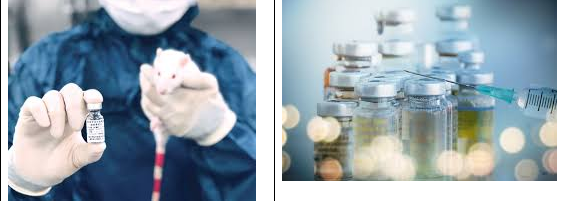

7. In ODF, use of any vaginal implant is not allowed.
8. In ODF, the focus is on preventing health problems and diseases through better /scientific management practices.
9. Prohibited
a) In ODF, farmers should not use preventive antibiotics.


Antibiotic Resistance
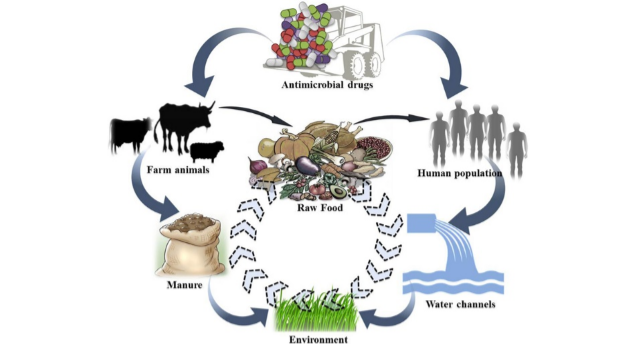
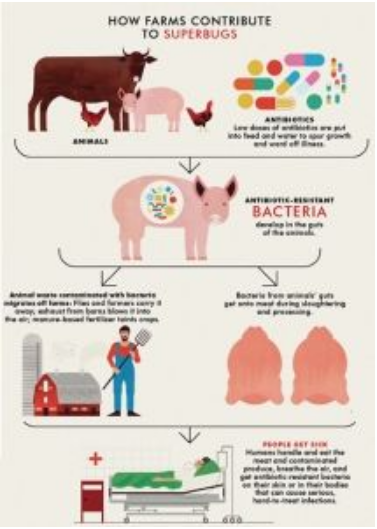
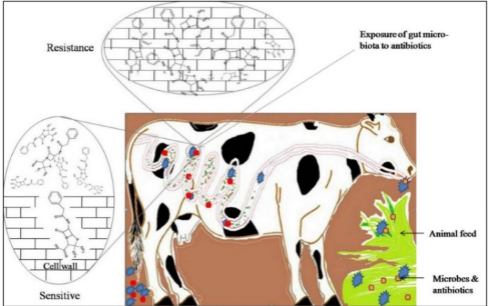
b) Substances of synthetic origin used to stimulate production or suppress natural growth are prohibited in ODF.
Producers use growth promoters to increase growth rates and improve overall efficiency and product quality. Various compounds have been tried for growth promotion, including hormones and antimicrobial agents. Natural hormones such estradiol (estrogen), progestrone and testosterone or synthetic hormones such as zeranol, melengestrol acetate and trenbolone acetate are widely used as growth promoters in animals.
The nontherapeutic use of wide spectrum of antimicrobial agents including ionophores is a common practice in improving animal production.
There is substantial recent evidence that residues of hormones in meat and meat products of treated animals may pose a risk to the consumers.
The adverse effects of hormones include developmental, neurobiological, genotoxic and carcinogenic effects.
Several European countries have restricted or banned the use of antibiotics as growth promoters because of the possible risks of future drug resistance in human following exposure to small doses of antibiotics in animal products.
Due to the various risks of antimicrobial agents and hormones, new alternative additives were suggested which may include microbial cultures (probiotics) that are now used in ruminants to manipulate certain biochemical events and the microbial composition of the rumen and prebiotic molecules such as oligosaccharides and lectins.
Pre- and probiotics do not exclude each other’s function and can or must be used simultaneously in order to obtain a powerful synergistic effects.
Risk of using growth promoting hormones:
Many researchers criticized the use of hormones such as steroid hormones, beta-agonists and somatotropins as growth promoters because their use may result in animal health and welfare risks and raise ethical questions.
They suggested that the choice to use hormones as growth promoters should not be left to self-regulation based on self-interest and/or be made subject to international trade agreements governed by economic considerations only.
In the production of food the price for the protection of the environment and the animals ought to be paid. It is time to make future oriented choices.
The use of six growth hormones 17β-oestradiol, progesterone, testosterone, zeranol, trenbolone and melengestrol acetate (MGA) for growth promotion in cattle poses a risk to the consumers .
This is the main finding of the Scientific Committee for Veterinary Measures relating to Public Health which has unanimously adopted an opinion on potential risks to human health from hormone residues in meat and meat products.
The adverse effects include developmental, neurobiological, genotoxic and carcinogenic effects.
Probiotics as Growth Promoters:
Probiotics are live microorganisms capable of inducing a beneficial effect on the balance of microorganisms in the digestive tract. With the appearance of the first problems related to the use of antibiotics, the possibility of using probiotics as growth promoters began to be seriously considered. They improve the production performance and the quality of products of animal origin.
10. Milk of sick animals treated with antibiotics can be consumed after drug withdrawal period.
When a person or an animal is given an antibiotic, it goes to work in the body. The antibiotic does its job killing bacteria, and the body does its job breaking down the antibiotic.
This break down takes different times for different antibiotics. It also takes different times in different animals (cows compared to pigs, for example). Some antibiotics have different break down times for different tissues (milk, meat, or liver for example).

What is Withdrawal period ?
The time it takes the body to break down the antibiotic until it is no longer functional or present is called the withdrawal time (or withdrawal period). Once the withdrawal period has passed the antibiotic has been eliminated from the animal’s system.
Common ab n their withdreal period
Oxytetracycline Residue Level at Different Withdrawal Period The detectable residue values of Oxytetracycline were 508, 387, 213, 113, 101, 43 and 7.5µg/kg at 1 day, 3 days, 5 days, 7 days, 9 days, 11 days and 13 days interval withdrawal periods respectively. The declared withdrawal periods of Oxytetracycline were 7days and safe level of that antibiotics were 120µg/kg respectively. The results indicated that the declared withdrawal periods and safe level of Oxytetracycline are almost nearest position which is shown in Figure 5. It was observed that 113µg/kg residue levels at declared withdrawal periods but the safe level is 120µg/kg.
Enrofloxacine Residue Level at Different Withdrawal Period From the control research results indicated that the detectable residue values of Enrofloxacin were 419, 272, 149, 112, 78, 36 and 12µg/kg at 1day, 3days, 5days, 7days, 9days, 11days and 13days interval withdrawal periods respectively. The declared withdrawal periods of Enrofloxacin were 7 days and safe level of that antibiotic were 70µg/kg respectively
Ciprofloxacin Residue Level at Different Withdrawal Period The detectable residue values of Ciprofloxacin were 390, 290, 163, 70, 41 and 19µg/kg at 1 day, 3 days, 5 days, 7 days, 9 days and 11 days interval withdrawal periods respectively. The declared withdrawal periods of Ciprofloxacin was 7 days and safe level of that antibiotic was 30µg/kg respectively. The results indicated that the declared withdrawal periods and safe level of Ciprofloxacin did not stay in same positions which are shown in Fig-2. It was observed that 70 µg/kg residue levels at declared withdrawal periods but the safe level is 30µg/kg.
Sulfonamide Residue Level at Different Withdrawal Period The detectable Sulfonamide residue values were 229, 140, 54 and 17µg/kg at 1 day, 3 days, 5 days and 7 days interval withdrawal periods respectively. The declared withdrawal period of Sulfonamide at 4 days were 100µg/kg respectively. The results indicated that the declared withdrawal periods and safe level of Sulfonamide did not stay in same points which are shown in Figure 3. It was reported that at 240µg/kg residue levels regarded as declared withdrawal periods but the safe level is 100µg/kg.
Gentamycin Residue Level at Different Withdrawal Period The detectable residue values of Gentamycin were 467, 366, 254, 188, 160, 136, 110 and 75µg/kg at 1 day, 3 days, 5 days, 7 days, 9 days, 11 days, 13 days and 15 days interval withdrawal periods respectively. The declared withdrawal periods of Gentamicin was 14days and safe level of that antibiotics was 100µg/kg respectively. The results indicated that the declared withdrawal periods and safe level of Gentamycin both were almost in at close position which is shown in Figure 7. It was observed that 110µg/kg residue levels at declared withdrawal periods but the safe level is 100µg/kg. So the declared withdrawal period of Gentamycin is true for our condition
Cloramphenical Residue Level at Different Withdrawal Period The detectable residue values of Cloramphenical were 220, 199, 169, 141, 127, 92, 69 and 37µg/kg at 1 day, 3 days, 5 days, 7 days, 9 days, 11 days, 13 days and 15days interval withdrawal periods respectively. The declared withdrawal periods of Cloramphenical was14 days and safe level of that antibiotic was 74µg/kg respectively. The results indicated that the declared withdrawal periods and safe level of Cloramphenical are almost at close the position which is shown in Figure 6. It was observed that 69µg/kg residue levels at declared withdrawal periods but the safe level is 74µg/kg.
WHY DOES THE WITHDRAWAL PERIOD MATTER?
These are two very important ways that farmers contribute to food safety every single day. First, by monitoring which medications they give to their animals, how much they give, and when they give it. Second, by maintaining accurate records and sticking to the withdrawal period. There are layers of monitoring in place to make sure that farmers are doing their due diligence and taking care of their animals, their families, and your families.
It simply takes time for the body to break antibiotics (or any medication) down to a form where the medicines are no longer functional and leave the body. This is why withdrawal periods are so important. Following withdrawal periods means that we know there are no traces of antibiotics in the meat or milk you buy at the grocery store. It means that farmers are doing everything they can to prevent the development of antibiotic resistance.
HOW DO I KNOW THERE ARE NO ANTIBIOTICS IN MY FOOD
I buy food for my family just like you do. I feed my growing toddler with food from the grocery store. Of course I worry about what he eats. But I never worry that he (or the rest of my family) will be exposed to antibiotics in food.
There are lots of food labels thrown around about antibiotics. And they all make antibiotics sound scary. The truth is that all of those labels are just marketing. No matter how your food was raised, it has to follow the same requirements and rules about antibiotics. Meat is tested to be sure that farmers are following the rules. These rules make it safe for you to eat meat and drink milk without worrying about “accidentally” consuming antibiotics.
FOOD LABELS ABOUT ANTIBIOTICS
The labels on food in the grocery stores are crazy. Here are some of the more common food labels about antibiotics you might see.
• No antibiotics used or Raised without antibiotics. Food with these labels is from animals that were never given antibiotics during their lives.
• No subtherapeutic antibiotics added or Not fed antibiotics. Food with these labels is from animals that were not fed subtherapeutic levels of antibiotics (for disease prevention). They may receive higher doses of antibiotics if they became sick and needed treatment.
Remember, even if your food does not have these labels on it, farmers still have to follow the rules, and milk and meat are tested for antibiotics. Every farmer must follow the rules. If any animal is treated with antibiotics, it must not enter the food supply until the withdrawal period has passed.
11. In ODF, good measures must be followed after the death of an animal due to any contagious disease.
There is a saying that “Postmortem examination is an art of disease diagnosis and the information we get is the message from the dead to the living”. Examination of the dead body by systemic dissection, recording of gross pathological lesions, and their correlation with history to make diagnosis of disease is called postmortem examination.
Indications of postmortem: A postmortem examination should be carried out whenever possible most preferably in sufficient day light and it should be done thoroughly. Postmortem examination should be followed by microbiology, parasitological, histopathological, toxicological and clinical pathology if needed for further zeroing the cause of death. It should be performed on following conditions:
• Whenever there is an outbreak of disease
• For any vetero-legal cases such as accidents, poisoning etc.
• For insured animals to issue death certificates
• Validating the Scientific research
• To know the cause of death: In any suspected cases of nature’s discourse . i.e. lightening, drowning, electric shock etc.

Points to remember while doing the postmortem:
Most of the veterinarians working in the field are forced to do a postmortem examination in a hurry or with some sort of local compulsion. One should remember the following conditions:
Confirmation of death prior to postmortem is must.
PM should not be conducted in carcass suspected to have died from anthrax (After suspecting the presence of anthrax bacilli in blood smear from ear vein or oozing out of unclotted blood)
PM should be conducted under sufficient day light.
1. Written consent of owner for doing the postmortem is a must. Requisition letter from competent authority (e.g. Police officer not below rank of inspector or magistrate) is particularly needed for vetrolegal and insurance related cases.
2. Recording details of animal identification (e.g. Ear tag, breed, sex, age, length, height, girth behind fore limb, distance between horn tips) and maximum possible history (including date and time of death) prior to postmortem is of prime importance.
3. Postmortem should not be done on carcass that are completely putrefied with liquefaction of all organs.
4. Postmortem should be done only when carcass is presented as whole body (In case of drowned animals carcass is to be taken out of water and presented for postmortem)
5. The carcass should be presented in its actual site as mentioned in the letter from owner/Police.
6. In case of any scheduled or endangered animal species, due consent, information/permission should be taken from local forest officials and/or police before proceeding for postmortem examination.
7. Postmortem area should be clean and the chances of environmental contamination should be minimal.
8. All natural orifices should be closed with towel or cotton wool soaked in a disinfectant solution before removing carcass to place of postmortem examination.
9. Handlers should protect themselves with gloves, apron, mask, cap, gumboot etc. to reduce the contaminations and infections. Movement of people to postmortem site should be restricted.
10. It is the duty of the veterinarians to ensure proper disposal of the carcass after postmortem either through deep burial, incineration or rendering.
Disposal and utilization of carcass
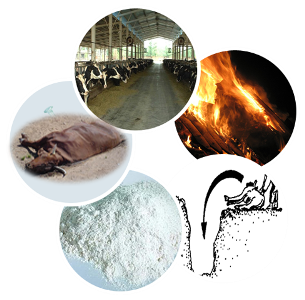
• The primary purpose of safe disposal of carcass is to ensure the check and spread of disease either to other susceptible animals or humans.
• Carcasses of animals may be disposed of by sending them to knackeries or by burial or burning.
Burial of carcasses
• Burial a suitable site should be selected. The burial place must be distant from a well or water course and there is a sufficiency of subsoil to allow a depth of 6 feet above the carcass.
• The carcass must be buried in its skin, be covered with a sufficient quantity of quicklime or other disinfectants.
• The dead animals should be arranged upon its back with feet upwards.
• The skin is slashed inside the pit all cases except ;in the case of anthrax.
• As the small of carcass may attract foxes and dogs the area of the burial needs to be disinfect with coal tar which will act as detergent for sufficient length of time.
Incineration/cremation/burning of carcasses
• There are 4 methods of cremation
o Pit method
o Surface burning method
o Flame gun method
o Incineration in a destructor
Pit method
• Pit method for the carcass of a large cow dig a pit measuring about 7 feet long, 4 feet wide and 18 inch deep is dug.
• A trench about 9 inches wide and 9 inches deep is next dug right across the bottom of the pit, the ends of this cross trench being the bottom of the pit, and sloped upwards so as to reach ground level about 2.5 feet from the edge of the pit.
• The object of this trench is to provide for draught and to facilitate the lighting of the fire. The fire may be laid in the following sequence.
o Fill the trench with straw soaked with paraffin to provide lighting points.
o Place a few piece of heavy timber, iron rails at intervals across the ventilation trench so as to prevent its obstructions.
o Cover bottom of pit with thin pieces of wood.
o Add large pieces of wood.
o Saturate with paraffin.
o Add coal
• The fire is started by lighting the straw at one or both ends of the lighting points.
Surface burning method
• This method can usefully be adopted when labour is scarce or when the nature of ground is not suitable for construction of pit i.e., when the land is water logged.
• Two parallel trenches about 5 feet long, 9 inches wide and 9 inches deep and 2 feet apart are dug in the direction of the prevailing wind at the site selected for cremation.
• The carcass is placed over the trenches.
• Coal is placed on and around the carcass.
• Wood is soaked with paraffin.
• A small quantity of paraffin saturated straw is added, the fire is then lit.
Flame gun method
• No pit or trench is required in this method. The carcass is placed on ground or corrugated iron sheet and a powerful flame directed towards it, destroy the carcass.
• The time taken depends on the number of flame guns used and the size of the animals.
Disposal of animal carcass:
The dead body of an animal is called carcass.
An animal carcass is a source of infections, therefore its proper disposal is a regulatory requirement.
Calf carcass after some moments of death following precautions and methods are followed for the disposal of an animal carcass.
(a) Precautions for carcass disposal:
(i) Wear personal protective equipment while handling the animal carcass.
(ii) Avoid direct contact with the dead animal’s blood, urine, faeces, etc.
(iii) Avoid contact with the dead animal’s parasites like lice, ticks, mites, etc.
(iv) If a carcass for disposal is required to be transported then place it in a plastic body bag and seal it immediately.
(b) Carcass disposal methods:
Any one of the following disposal methods can be adopted for the proper disposal of animal carcass.
(i) Burial: Burial is a commonly used method. In this method, animal carcasses are disposed in a deep pit, followed by covering it with layers of lime and soil.
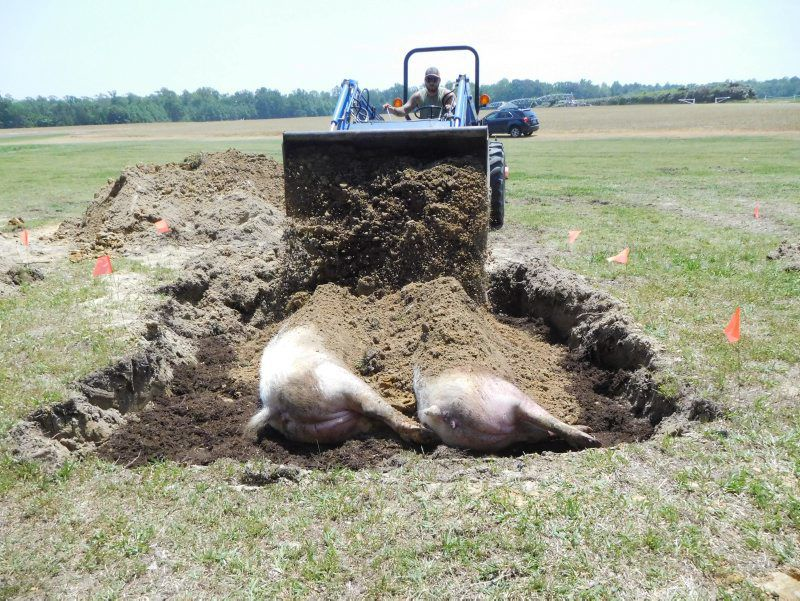
(ii) Burning: Burning is a well-established procedure where wood or fire beds soaked in kerosene or diesel are kept around the animal carcass and ignited with fire. Care is taken to keep away the vehicles and burning materials from the ignition point.
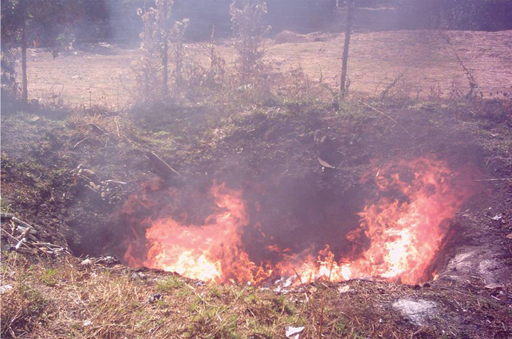
(iii) Incineration: In this method, animal carcasses are incinerated in an incinerator which is a fixed machine fuelled by natural gas or electricity. The whole carcass is burned and reduced to ashes. This method effectively inactivates the pathogens but is quite expensive.
